by Jason Bodner
May 9, 2023
Worth is entirely subjective. One example is back when tulips were worth more than gold. In the 1630s, tulips were only for the very wealthy. The famed tulip speculative bubble vaulted the Rembrandt-bulb to the equivalent of $1,500, 10 times the annual income of a skilled craftsman or the price of a large house.
Currently, the stock market’s value seems most often correlated to one man’s words: Jerome Powell.
Well, last Wednesday, Mr. Powell spoke again. Market volatility followed, attributed to his “hawkish” comments, but I don’t agree. I found positivity in Powell’s statements. I see most of the market’s volatility related to earnings, along with some seasonality, and both make me bullish for the back half of the year.
Investors wonder if the Fed is done raising rates… Are we headed for recession? What will stocks do?
There’s still a ton of negativity out there. The media continues to haul out fearful headlines, like:
- Nuclear threats in the Russia/Ukraine war.
- A coming recession
- Economic stress
- Banking collapses
There’s plenty to fear – always. Some worry that when the Fed reverses course, it could sink stocks. I have data that says the opposite. In fact, the average three- and six-month return of the S&P 500 after the final rate hike in a tightening cycle is positive, on average, and for the last five cycles in a row:
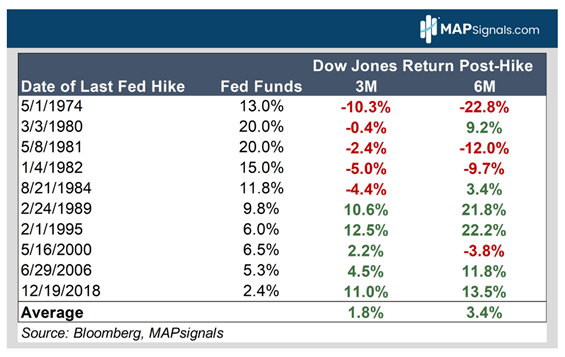
Graphs are for illustrative and discussion purposes only. Please read important disclosures at the end of this commentary.
Unfortunately, our minds are hard-wired to focus on the negative. This survival instinct served us well throughout our species’ development, but as investors, I think we should rather focus on data.
I listened to the FOMC statement and subsequent press conference. Here are my takeaways:
- Powell began his statement by saying that the banking system is sound and resilient. (Ironically, later that same day PacWest (PACW) dropped 50% after hours after reporting horrific earnings.)
- After restating a rate increase of 25 basis points to 5.00-5.25%, he reiterated the Fed’s mandate of maximum employment, price stability, and the Fed’s long-term goal of 2% inflation.
- He said tighter credit conditions would further slow the economy.
- The Fed continues to reduce securities holdings – lightening the balance sheet.
- Most importantly, he had a change of tone: We will be data dependent to determine if further tightening policy is necessary. In fed-speak, I interpret that to mean, “We are done tightening.”
- Powell sees policy tightening has effects on demand (housing and investment).
- He said the economy has slowed significantly: Growth is modest, and housing is weakening, largely due to higher mortgage rates. Higher interest rates are hampering economic growth.
- The labor market is still hot. There are some signs that supply and demand in labor are coming back into balance, but demand still outstrips supply.
- The banking sector is causing tightening credit conditions, which will further slow the economy.
In my view, this means that with higher rates, reducing the balance sheet (reducing liquidity), and tighter credit conditions (harder borrowing), the war against inflation is working. This means that future policy action is based on what data comes in. In fact, he said, “We will go meeting by meeting.”
This contributes to why I am bullish for the back half of the year….
First, we see inflation falling hard. We see inflation (as measured by the CPI) and the Fed funds effective rate almost at parity for the first time since prior to COVID. Notice also that when rates rise above inflation, recent history suggests they fall thereafter. This sets up for upside for stocks:
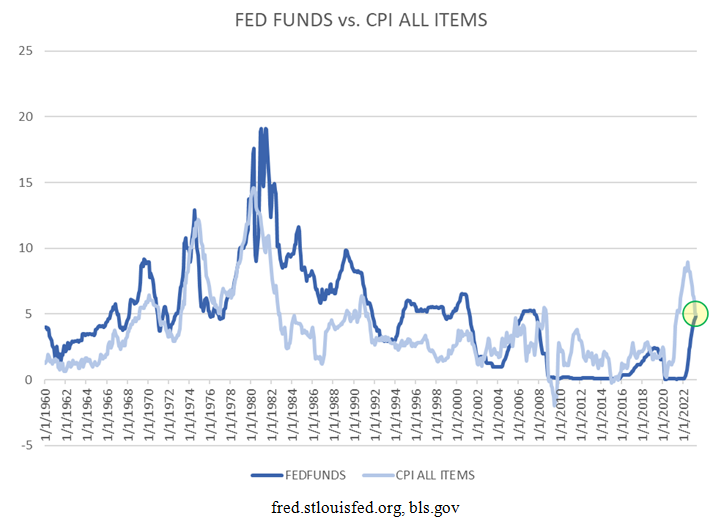
Graphs are for illustrative and discussion purposes only. Please read important disclosures at the end of this commentary.
Also, the Earnings Apocalypse forecasted by the media, simply hasn’t come true. In fact, it’s the opposite. According to FactSet, as of May 7, for Q1 2023 (with 85% of S&P 500 companies reporting results), 79% of S&P 500 companies beat earnings estimates and 75% beat revenue estimates. That’s fantastic.
There is one problem: Guidance. Many companies are issuing cautious guidance or lowering it altogether. We see the effect of lower guidance on great companies. For instance, several stocks beat sales and earnings estimates, but traded down on weaker guidance. For example, REGN, a phenomenal healthcare company, has beaten earnings estimates 16 straight quarters and sales estimates 14 of the last 16 quarters.
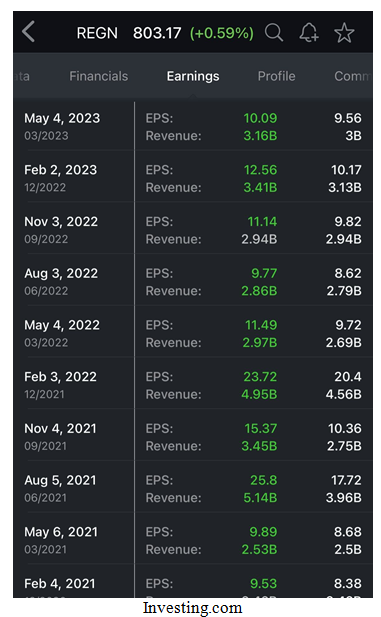
Graphs are for illustrative and discussion purposes only. Please read important disclosures at the end of this commentary.
That’s amazing.
If I ran a public company, I would issue conservative guidance. I’d rather under-promise and over-deliver. I imagine many companies are now conservative about guidance, creating an uncertain economic landscape. Imagine, then, if companies continue beating earnings in Q3 and Q4: This sets up an upside.
Also, there’s loads of cash on the sidelines. In fact, it’s the highest amount on record, ever:
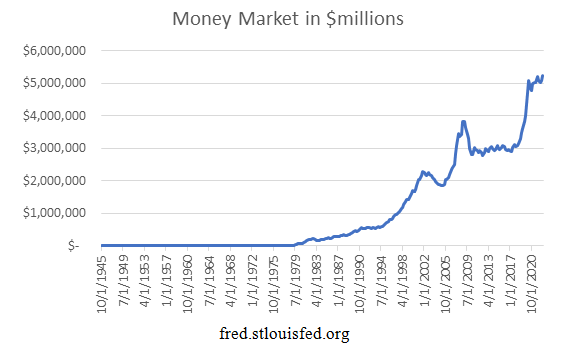
Graphs are for illustrative and discussion purposes only. Please read important disclosures at the end of this commentary.
Should rates cool, inflation abate, and earnings continue to surprise positively, the market will naturally strengthen. Then, as investors fear missing out – that record cash will begin to chase a hot equity market.
Before we get ahead of ourselves, we need to be aware of seasonality. We’ve all heard sell in May and go away. There is truth here. Look at the monthly returns of the S&P 500 since January of 1990:
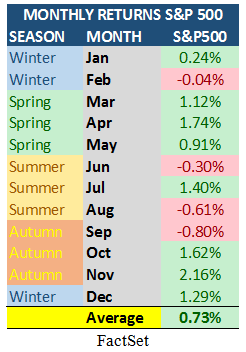
Graphs are for illustrative and discussion purposes only. Please read important disclosures at the end of this commentary.
June through September look weak. This means we should enjoy our summer. As for stocks, summer is great for outperforming stocks to reveal themselves. They say: rising tides lift all boats. That’s true, but falling tides reveal what’s underwater. It could be smelly fish, or hidden treasure.
In summary:
- The Fed is pretty much done raising rates. When answering a Barron’s reporter’s question, Powell said that: Support for a 25 bp increase was strong across board. There was talk of pausing but not at this meeting. But there is a sense of being much closer to the end than the beginning – We’re getting close or are even already there.
- Inflation is falling and at parity for the first time since pre-COVID, which sets up for lower rates in the future.
- Earnings are working, with cautious guidance that could set up for upside in the event of continued surprises.
- There’s record cash waiting for deployment.
- And lastly, while seasonality looks ho-hum for the summer, look again at the last months of the year. Q4 is historically very strong.
Keep this in mind while trying to enjoy your summer: Data can give us a way to solve the markets.
While Churchill was talking about Russia when he said this famous quote, the same could be said for stocks:“Russia is a riddle wrapped in a mystery inside an enigma.”
Navellier & Associates Inc. does not own PacWest Bancorp (PACW), or Regeneron Pharmaceuticals (REGN) in managed accounts. Jason Bodner does not own PacWest Bancorp (PACW), or Regeneron Pharmaceuticals (REGN) personally.
All content above represents the opinion of Jason Bodner of Navellier & Associates, Inc.
Also In This Issue
A Look Ahead by Louis Navellier
Employment Reports & ISM Numbers Reflect a Growing Economy
Income Mail by Bryan Perry
Some Beaten Down REIT Subsectors Deserve a Closer Look
Growth Mail by Gary Alexander
When Gresham’s Law Meets a Debt Ceiling, Gold Can Soar
Global Mail by Ivan Martchev
If Bank Stocks Can Rally, the Market Can Rally Some More
Sector Spotlight by Jason Bodner
Some Takeaways from Chairman Powell’s Mid-Week Musings
View Full Archive
Read Past Issues Here

Jason Bodner
MARKETMAIL EDITOR FOR SECTOR SPOTLIGHT
Jason Bodner writes Sector Spotlight in the weekly Marketmail publication and has authored several white papers for the company. He is also Co-Founder of Macro Analytics for Professionals which produces proprietary equity accumulation/distribution research for its clients. Previously, Mr. Bodner served as Director of European Equity Derivatives for Cantor Fitzgerald Europe in London, then moved to the role of Head of Equity Derivatives North America for the same company in New York. He also served as S.V.P. Equity Derivatives for Jefferies, LLC. He received a B.S. in business administration in 1996, with honors, from Skidmore College as a member of the Periclean Honors Society. All content of “Sector Spotlight” represents the opinion of Jason Bodner
Important Disclosures:
Jason Bodner is a co-founder and co-owner of Mapsignals. Mr. Bodner is an independent contractor who is occasionally hired by Navellier & Associates to write an article and or provide opinions for possible use in articles that appear in Navellier & Associates weekly Market Mail. Mr. Bodner is not employed or affiliated with Louis Navellier, Navellier & Associates, Inc., or any other Navellier owned entity. The opinions and statements made here are those of Mr. Bodner and not necessarily those of any other persons or entities. This is not an endorsement, or solicitation or testimonial or investment advice regarding the BMI Index or any statements or recommendations or analysis in the article or the BMI Index or Mapsignals or its products or strategies.
Although information in these reports has been obtained from and is based upon sources that Navellier believes to be reliable, Navellier does not guarantee its accuracy and it may be incomplete or condensed. All opinions and estimates constitute Navellier’s judgment as of the date the report was created and are subject to change without notice. These reports are for informational purposes only and are not a solicitation for the purchase or sale of a security. Any decision to purchase securities mentioned in these reports must take into account existing public information on such securities or any registered prospectus.To the extent permitted by law, neither Navellier & Associates, Inc., nor any of its affiliates, agents, or service providers assumes any liability or responsibility nor owes any duty of care for any consequences of any person acting or refraining to act in reliance on the information contained in this communication or for any decision based on it.
Past performance is no indication of future results. Investment in securities involves significant risk and has the potential for partial or complete loss of funds invested. It should not be assumed that any securities recommendations made by Navellier. in the future will be profitable or equal the performance of securities made in this report. Dividend payments are not guaranteed. The amount of a dividend payment, if any, can vary over time and issuers may reduce dividends paid on securities in the event of a recession or adverse event affecting a specific industry or issuer.
None of the stock information, data, and company information presented herein constitutes a recommendation by Navellier or a solicitation to buy or sell any securities. Any specific securities identified and described do not represent all of the securities purchased, sold, or recommended for advisory clients. The holdings identified do not represent all of the securities purchased, sold, or recommended for advisory clients and the reader should not assume that investments in the securities identified and discussed were or will be profitable.
Information presented is general information that does not take into account your individual circumstances, financial situation, or needs, nor does it present a personalized recommendation to you. Individual stocks presented may not be suitable for every investor. Investment in securities involves significant risk and has the potential for partial or complete loss of funds invested. Investment in fixed income securities has the potential for the investment return and principal value of an investment to fluctuate so that an investor’s holdings, when redeemed, may be worth less than their original cost.
One cannot invest directly in an index. Index is unmanaged and index performance does not reflect deduction of fees, expenses, or taxes. Presentation of Index data does not reflect a belief by Navellier that any stock index constitutes an investment alternative to any Navellier equity strategy or is necessarily comparable to such strategies. Among the most important differences between the Indices and Navellier strategies are that the Navellier equity strategies may (1) incur material management fees, (2) concentrate its investments in relatively few stocks, industries, or sectors, (3) have significantly greater trading activity and related costs, and (4) be significantly more or less volatile than the Indices.
ETF Risk: We may invest in exchange traded funds (“ETFs”) and some of our investment strategies are generally fully invested in ETFs. Like traditional mutual funds, ETFs charge asset-based fees, but they generally do not charge initial sales charges or redemption fees and investors typically pay only customary brokerage fees to buy and sell ETF shares. The fees and costs charged by ETFs held in client accounts will not be deducted from the compensation the client pays Navellier. ETF prices can fluctuate up or down, and a client account could lose money investing in an ETF if the prices of the securities owned by the ETF go down. ETFs are subject to additional risks:
- ETF shares may trade above or below their net asset value;
- An active trading market for an ETF’s shares may not develop or be maintained;
- The value of an ETF may be more volatile than the underlying portfolio of securities the ETF is designed to track;
- The cost of owning shares of the ETF may exceed those a client would incur by directly investing in the underlying securities; and
- Trading of an ETF’s shares may be halted if the listing exchange’s officials deem it appropriate, the shares are delisted from the exchange, or the activation of market-wide “circuit breakers” (which are tied to large decreases in stock prices) halts stock trading generally.
Grader Disclosures: Investment in equity strategies involves substantial risk and has the potential for partial or complete loss of funds invested. The sample portfolio and any accompanying charts are for informational purposes only and are not to be construed as a solicitation to buy or sell any financial instrument and should not be relied upon as the sole factor in an investment making decision. As a matter of normal and important disclosures to you, as a potential investor, please consider the following: The performance presented is not based on any actual securities trading, portfolio, or accounts, and the reported performance of the A, B, C, D, and F portfolios (collectively the “model portfolios”) should be considered mere “paper” or pro forma performance results based on Navellier’s research.
Investors evaluating any of Navellier & Associates, Inc.’s, (or its affiliates’) Investment Products must not use any information presented here, including the performance figures of the model portfolios, in their evaluation of any Navellier Investment Products. Navellier Investment Products include the firm’s mutual funds and managed accounts. The model portfolios, charts, and other information presented do not represent actual funded trades and are not actual funded portfolios. There are material differences between Navellier Investment Products’ portfolios and the model portfolios, research, and performance figures presented here. The model portfolios and the research results (1) may contain stocks or ETFs that are illiquid and difficult to trade; (2) may contain stock or ETF holdings materially different from actual funded Navellier Investment Product portfolios; (3) include the reinvestment of all dividends and other earnings, estimated trading costs, commissions, or management fees; and, (4) may not reflect prices obtained in an actual funded Navellier Investment Product portfolio. For these and other reasons, the reported performances of model portfolios do not reflect the performance results of Navellier’s actually funded and traded Investment Products. In most cases, Navellier’s Investment Products have materially lower performance results than the performances of the model portfolios presented.
This report contains statements that are, or may be considered to be, forward-looking statements. All statements that are not historical facts, including statements about our beliefs or expectations, are “forward-looking statements” within the meaning of The U.S. Private Securities Litigation Reform Act of 1995. These statements may be identified by such forward-looking terminology as “expect,” “estimate,” “plan,” “intend,” “believe,” “anticipate,” “may,” “will,” “should,” “could,” “continue,” “project,” or similar statements or variations of such terms. Our forward-looking statements are based on a series of expectations, assumptions, and projections, are not guarantees of future results or performance, and involve substantial risks and uncertainty as described in Form ADV Part 2A of our filing with the Securities and Exchange Commission (SEC), which is available at www.adviserinfo.sec.gov or by requesting a copy by emailing info@navellier.com. All of our forward-looking statements are as of the date of this report only. We can give no assurance that such expectations or forward-looking statements will prove to be correct. Actual results may differ materially. You are urged to carefully consider all such factors.
FEDERAL TAX ADVICE DISCLAIMER: As required by U.S. Treasury Regulations, you are informed that, to the extent this presentation includes any federal tax advice, the presentation is not written by Navellier to be used, and cannot be used, for the purpose of avoiding federal tax penalties. Navellier does not advise on any income tax requirements or issues. Use of any information presented by Navellier is for general information only and does not represent tax advice either express or implied. You are encouraged to seek professional tax advice for income tax questions and assistance.
IMPORTANT NEWSLETTER DISCLOSURE:The hypothetical performance results for investment newsletters that are authored or edited by Louis Navellier, including Louis Navellier’s Growth Investor, Louis Navellier’s Breakthrough Stocks, Louis Navellier’s Accelerated Profits, and Louis Navellier’s Platinum Club, are not based on any actual securities trading, portfolio, or accounts, and the newsletters’ reported hypothetical performances should be considered mere “paper” or proforma hypothetical performance results and are not actual performance of real world trades. Navellier & Associates, Inc. does not have any relation to or affiliation with the owner of these newsletters. There are material differences between Navellier Investment Products’ portfolios and the InvestorPlace Media, LLC newsletter portfolios authored by Louis Navellier. The InvestorPlace Media, LLC newsletters contain hypothetical performance that do not include transaction costs, advisory fees, or other fees a client might incur if actual investments and trades were being made by an investor. As a result, newsletter performance should not be used to evaluate Navellier Investment services which are separate and different from the newsletters. The owner of the newsletters is InvestorPlace Media, LLC and any questions concerning the newsletters, including any newsletter advertising or hypothetical Newsletter performance claims, (which are calculated solely by Investor Place Media and not Navellier) should be referred to InvestorPlace Media, LLC at (800) 718-8289.
Please note that Navellier & Associates and the Navellier Private Client Group are managed completely independent of the newsletters owned and published by InvestorPlace Media, LLC and written and edited by Louis Navellier, and investment performance of the newsletters should in no way be considered indicative of potential future investment performance for any Navellier & Associates separately managed account portfolio. Potential investors should consult with their financial advisor before investing in any Navellier Investment Product.
Navellier claims compliance with Global Investment Performance Standards (GIPS). To receive a complete list and descriptions of Navellier’s composites and/or a presentation that adheres to the GIPS standards, please contact Navellier or click here. It should not be assumed that any securities recommendations made by Navellier & Associates, Inc. in the future will be profitable or equal the performance of securities made in this report.
FactSet Disclosure: Navellier does not independently calculate the statistical information included in the attached report. The calculation and the information are provided by FactSet, a company not related to Navellier. Although information contained in the report has been obtained from FactSet and is based on sources Navellier believes to be reliable, Navellier does not guarantee its accuracy, and it may be incomplete or condensed. The report and the related FactSet sourced information are provided on an “as is” basis. The user assumes the entire risk of any use made of this information. Investors should consider the report as only a single factor in making their investment decision. The report is for informational purposes only and is not intended as an offer or solicitation for the purchase or sale of a security. FactSet sourced information is the exclusive property of FactSet. Without prior written permission of FactSet, this information may not be reproduced, disseminated or used to create any financial products. All indices are unmanaged and performance of the indices include reinvestment of dividends and interest income, unless otherwise noted, are not illustrative of any particular investment and an investment cannot be made in any index. Past performance is no guarantee of future results.
